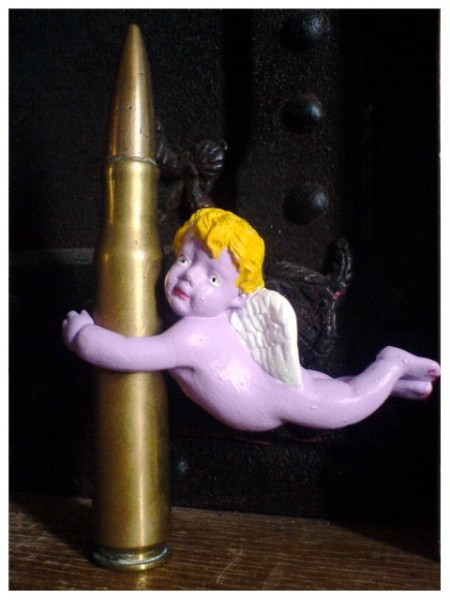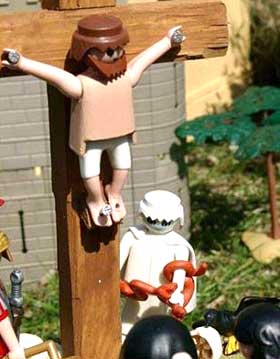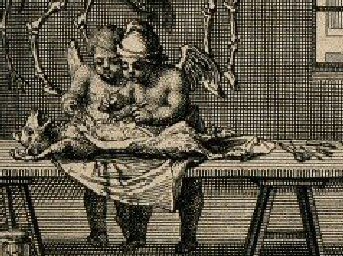Referring to a player called Rolando, the commentator on last night’s Champions League football match said:
“I wonder how long it is since Ronaldo was marked by an anagram of himself?”
Exquisite.

Referring to a player called Rolando, the commentator on last night’s Champions League football match said:
“I wonder how long it is since Ronaldo was marked by an anagram of himself?”
Exquisite.
Letters have been pouring in from readers eager to make their own putti, wondering how to go about doing so. Here, for example, is Tim Thurn:
Dearest Frank, he writes, in his overfamiliar way, I am eager to make a putto of my own, but have absolutely no idea how to go about it. Can you offer any tips to a cack-handed reader whose previous efforts at craft projects have ended in disaster? Passionately yours, Tim.
The first thing I will say is that cack-handedness, in and of itself, should never deter a Hooting Yard reader from undertaking any craft project, however complicated. As M People put it so eloquently, “you’ve got to search for the hero inside yourself”. Do you think for one minute that heroes such as Ulysses or Tristram Shandy or Watt would have shrunk from the challenge of putto-making, had they had to face it? No, they would not. So stop whimpering and just get on with it.
To make your own putto, it is absolutely imperative that you first acquire a grounding in the art of the Renaissance. In fact, you need more than a grounding. Ideally, you should be able to triumph over Bernard Berenson in a quiz on the subject. Berenson has been dead since 1959, so to prove your mettle you must consult a backstreet medium and have him or her summon the shade of Berenson from the Other Side. Apart from their immense knowledge of things past, present, and to come, spectral beings from beyond the grave can be surprisingly quick on the buzzer in tense quiz-type situations, so you should get in some fairly hefty practice. Tecwen Whittock, whose coughing prompted correct answers from Major Charles Ingram in the great Who Wants To Be A Millionaire? cheating affaire of 2001, and was himself a contestant on the show, built his own homemade four-button console and rehearsed on it for hours. This is the kind of preparation you would do well to imitate before facing the spirit of Bernard Berenson in a Renaissance art quizathon.
Having, I hope, crushed the shade of Berenson and demonstrated your sweeping knowledge of the subject, you will now be in a position to make your own putto. Get some putty, mould it into a putto, give it a lick of paint, and voila!, there you have it. One reader who tried this out was OutaSpaceman, and here is the result:

If you wish to make edible putti, for the decoration of cakes and pastries and so on, you can use dough instead of putty, and food colourants instead of paint. A generous slice of chocolate swiss roll upon which a pair of dough putti are disporting themselves makes the perfect addition to a worker’s lunchbox, and is said to aid productivity on the factory floor, according to the nutritionist Catnip Wedge. Wedge has been dead even longer than Bernard Berenson, but he proffered his opinion when his phantom, bespattered rather disgustingly with an excess of ectoplasm, was summoned by Madame Boubou, the backstreet medium I consulted.
There is much to instruct, entertain and amuse in Flaubert’s Dictionary Of Received Ideas. It is tempting to quote something from every page. But for now, ponder this, and ponder it well:
DUCKS. Always come from Rouen.
Much as all eels emerge from the wide Sargasso sea, I suppose.
Ordinarily, under the Bolsheviks, beyond the Urals, the achievements of a hero worker were not celebrated by the energetic bashing of bongos. Yet this is precisely what happened with Babinsky. The teenage repair man’s record-breaking feats of repair were so wondrous, his proletarian heroics without parallel, that he was told he could devise his own ceremony.
“Bongos. Thousands of them!” grunted the lanky worker. His moustache was incipient and not yet the massive walrus it would later grow into.
Local Party bigwigs were disconcerted by his choice, but reasoned that if they pooh-poohed his desires they might well be carted off to camps, or even shot. So talismanic was Babinsky’s name, in that brief golden summer, he could have asked for anything. And so they set about obtaining thousands of sets of bongos and drilling the other workers in the rhythmic bashing of them. This was not without its difficulties, for beyond the Urals the average worker was too downtrodden and exhausted to put much vim into endless hours of bongo practice after a day’s drudgery in the factory.
The factory, a vast complex set within a vaster complex in an industrial island plopped in the middle of immense snow-bound nothingness, produced bolts and screws and tyres and spikes and washers, oh, all sorts of metal and rubber bits and pieces, and relied on an array of engines and machinery which was prone to clogging and collapse and jamming up and fracturing, and it was Babinsky, with his delicate fingers and his methodical brain and his familiarity with grease and his inhuman concentration, who fixed everything, sometimes before it was broken. He was a marvel, and the factory Soviet knew it, and so he was mollycoddled and lacked for nothing. If he wanted a bongo ceremony, he would have one.
There was surprisingly little resentment of Babinsky among his fellow workers. Often, those singled out for eminence by the Party were loathed, and muttered about behind their backs. It was not unknown for a model worker, shortly after the ceremony extolling his virtues, to suffer what looked like an accident, or to be denounced, or to have poison tipped in to his lunchpail. The teenage repair man, on the other hand, was regarded in the tradition of the Holy Innocent, or Holy Fool. His bongo choice seemed confirmation of this. Most hero workers opted for the standard ceremony with massed tractors and long speeches and a supper of unusually thick borscht.
Of course, there was nothing the least bit holy about Babinsky. Nor was he innocent, nor foolish. Inside his spindly frame beat a tarry black heart, and within his cranium throbbed the brain of a devil. To Babinsky’s inner ear, that throbbing sounded like the pounding of a thousand bongos, and it was that infernal din he wanted to recreate, in the world outside his head, at his ceremony.
And all unwittingly, because he was so magnificent a repair man, the Soviet authorities acquiesced. Was it the massed bashing of bongos on that golden summer evening that tipped Babinsky over the edge? To the teenager, it was as if he could make real the demonic pulsations in his head. Only two weeks later, he embarked upon the first of his rampages.
In years to come, there was much guilt among the workers who beat bongos for Babinsky. Intuitively, they knew, if the Party bigwigs did not, that they had helped unleash the repair man’s furies. Most of them never bashed bongos again, though a few of them had caught the bug, and formed underground beatnik clubs where bongos were bashed in caverns far away from the railway tracks. Even here, as they smoked exotic Tunisian black market cigarettes and preened their goatees, the bongoists told themselves they were trying to exorcise the evil of Babinsky. They would have been better occupied smashing rocks in Siberia.
The moral of the story is always to opt for the tractors and the speeches and the borscht, even if the borscht is thin and watery and akin to beetroot-based gruel.
“It’s true that I did use a hairdryer to soften the figure for the crucifixion scene because the fingers wouldn’t spread out properly otherwise. Then I had to let it harden again before I could nail it to the cross.”
Gosh, how often have I said the very same thing? The Freethinker is on the case.

Â
Speaking of malevolent putti, as I was below, here is a picture of a pair of them dissecting a dog. Elsewhere in the image, of which this is a detail, another couple of cherubs are examining the entrails of a freshly-slaughtered hare. So, for your own good, don’t be taken in by their oh-so-cutesy appearance!

From the Wellcome Library, via Holly Tucker at the splendid Wonders & Marvels.
With my fife and my drum I wandered in the hills. I tooted my fife and I banged my drum. This was why I was wandering in the hills, for I had been banished from town. My tooting and banging unnerved the good burghers, and the bad burghers too, and I was escorted to the town perimeter and shoved across the line. It was an actual line, painted in whitewash, and regularly repainted wherever it lost integrity through scuffing by bootsoles and the like. I was told plainly, by way of an edict, that I could never again toot my fife or bang my drum within the town, due to the unnervement I caused. I accepted this, and wandered up into the hills.
Toot toot toot! Bang bang bang! Toot toot bang bang toot! Bang! I was as happy as a sandboy, although I am not entirely sure what a sandboy is, unless it be a remarkably happy boy made out of wet impacted sand by some beach-bound Geppetto.
I was happy in the hills until I was attacked by a flock of putti. No one had ever thought to tell me that the sky above the hills was infested by chubby curly-locked cherubs from the Italian Renaissance, some armed with bows and arrows, and all blessed with the power of flight. Whenever I had seen pictures of them, during my lessons, I understood them to be harmless. Mischievous, yes, but in a playful way. It came as a shock to me to discover that they were demented and malevolent, never a good combination. They also seemed to object to my tooting on my fife and my banging on my drum. I took shelter in a recently-vacated bivouac.
You should always take care, in the hills, when occupying a vacant bivouac, to find out if it has been wholly abandoned or if the person who built it is due back shortly. That person might be large and menacing with hairy fists and wild eyes. Many hill dwellers fit that description. I saw dying embers from a fire, and some spat-out gristle from a sausage, neither of which told me whether or not I could expect company. The putti continued to swoop in the sky above, ready to renew their attack if they got the chance. I judged that, if a large hairy hill-person were to return to claim his bivouac, I could frighten him off with tooting and banging. Such ogres are usually averse to a din. But unless the putti flew away, I was trapped. I could only hope their attentions might be distracted by a passing goat or peasant. I wanted to wander, yet here I was stuck in a bivouac. To pass the time, I tooted my fife and banged my drum.
About an hour later, the maker of the bivouac returned. It was not, as I had surmised, a large and ungainly hill-person, but grumpy German film director Horst Gack. The putti swooped upon him as he approached, the armed ones firing golden arrows at him, but he simply shouted at them and waved his fist, as hairy as a hill-person’s fist, and they dispersed, with babyish squeaks. I wondered why I had not thought to use Gack’s simple tactics. But then, the presiding genius of the Cinema of Belligerence had a guttural shout and an aggressive fist-brandishment beyond compare.
He was unconcerned that I was occupying his bivouac. Indeed, as soon as he saw my fife and my drum he questioned me closely about them. He was a very intense man, as you might expect. As he fried sausages over the rekindled fire, he told me that a fife and drum soundtrack would suit the film he was working on, here in this bivouac, a seven-hour black-and-white documentary about hillside goats and ogres. He explained that he had just been out and about shooting raw footage of a goat-versus-ogre wrestling bout. I did some tooting and banging for him, and he seemed pleased, though it was difficult to tell given his grim demeanour. He gave me one of his sausages.
Little did I know, as darkness fell upon the hills, that six months later I would stand on stage accepting an award as runner-up in the Most Belligerent Soundtrack award at a film festival in Ṻlm. Curiously, the trophy itself was a statuette of a putto, curly-locked and chubby and armed with a bow and arrow. I took it home, to my new home, just outside the town perimeter, and I put it on my mantelpiece, and every now and then, as the fancy took me, I smashed it to smithereens with a hammer, and then glued it back together. Now, when I wander in the hills tooting my fife and banging my drum, the putti leave me be.Â
“Attention to and gratitude for socks is not a commonly expressed attitude.” – Theodore Dalrymple in the New English Review.
The BBC has a clip of London Mayor Boris Johnson getting a bit grumpy and walking out of a Commons Select Committee meeting where he is being questioned about the recent snowfall. Viewers are then offered the chance to watch similar video clips – I assume that is the meaning of “More Like This” – including “Snow-crazed stoat ‘goes berserk'”. Mayor, stoat… can you tell the difference?
Incidentally, I liked the Mayor’s recent comment on some aspect, I forget which, of the global economic meltdown – “the medium has spoken but we have yet to see the ectoplasm!”Â
Equally superb was Peter Mandelson’s reply to an interviewer who asked him how he felt to be involved in “the fulcrum of history” (illiterate hyperbabble for the G20 summit). Â “The soup’s nice,” said Mandelson.
You know, in a very real sense, if Jesus were here today, faced with global financial meltdown and other topical newspaper headlines, he would, I think, wear a chunky knitted cardigan. Most sensible folk would do the same.
Mr Key, on the other hand, is going to barricade himself inside Fort Hoity. Or possibly Fort Toity.

Â
Just as a bus is the best place for abuse, you should ideally perform abasement in a basement. There is something about the subterranean nature of the location which lends itself to the embrace of personal wretchedness.
Obviously the basement must first be prepared with the installation of a shrine or altar to an enraged and merciless deity, for example the hideous bat-god Fatso, or Allah. Adherents of the latter usually claim he is all-merciful, but come on, we all know that is twaddle. Allah does as much smiting as Jehovah, and has an extremely lengthy list of harmless deeds he construes as wrongdoing. His sin-catalogue is almost as bulky as Fatso’s. Whether you choose Jehovah or Allah or Fatso is entirely up to you. The important thing is to have a focus for your grovelling in your basement.
Once you have installed your shrine or altar or whatsit, never again bother to sweep the floor of your basement with a broom. By allowing dust and debris to settle and moulder, you create an apt surface upon which to prostrate yourself, flat on your belly, while bewailing your utter worthlessness. If you have picked for your deity one of the ones that allows itself to be depicted by human hand, make sure the picture or icon is terrifying in its intensity and shows the god in a particularly bad temper. Actually, you can do this for one of the image-forbidding gods too, because by having wrought a picture of them you will just make them more enraged, and the angrier they are the better, as far as your abasement is concerned.
I hope it is clear why you should avoid a woolly liberal deity like gentle Jesus, in a chunky Church of England cardigan, whose reaction to your begrovelment would as likely as not be a compassionate smile and a helping hand to lift you from the grubby floor. If you are going to get the hang of this abasement business, you want to provoke wrath and scourges and plagues of locusts and thunderbolts.
There is no minimum time to spend face down in the muck in the dark of your basement. A properly vengeful and psychotic deity will not be assuaged with a mere ten or fifteen minutes here or there. Best to plan for the day, and night, and the following day, and the night again, at least. And no sneaking up to the kitchen for a snack. Unless, of course, it is a diet of worms.